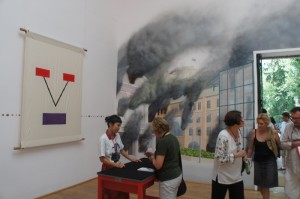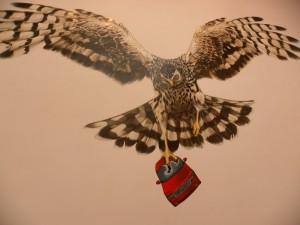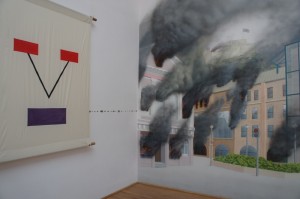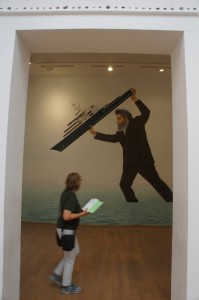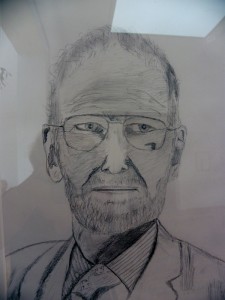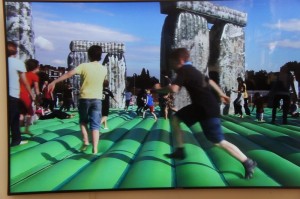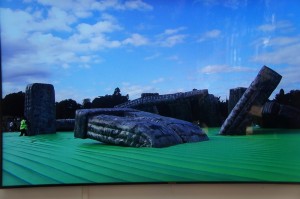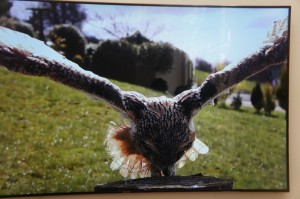English Magic
Jeremy Deller’s Pavilion for Great Britain at the Venice Biennale includes a lot of disparate elements, none of which the artist made. He does not paint, sculpt, photograph or draw. Rather he assembles objects and images (giving credit to those who make them).
By calling the pavilion “English Magic” he is off the hook on making a point, magic is of course sleight of hand, illusion, based on practice, but not substance. It is hard to tell what he is passionate about in this pavilion. He gives us several issues, but there is a Warholian detachment about the sum of the parts.
Andy Warhol was apparently a profound inspiration for Deller who mostly studied art history in school. Perhaps that is why he made a categorical statement that “good art shouldn’t try to do anything useful” to Emily Stokes of the Financial Times (Aug 2, 2013) and added, just to be sure we understood his position that “art gets co-opted by politicians to solve social problems.” These kinds of ideas would be the direct heritage of the modernist tradition of art history: its formalist emphasis for many decades (including those when he was studying), excluded social and political context from the meaning of the work. Fortunately that has entirely changed now.
Here are the various issues Deller presents, none of them necessarily related to one another, in the order in which we pass through them in the UK pavilion.
In the first room is a large banner photograph of a hen harrier hawk carrying a range rover in his talons, with a narrative that the rare hawk was purportedly shot by Prince Harry ( his car being carried off ?) and a friend on the Sandringham Estate in October 2007;
There are also a lot of neolithic arrowheads and axes actually displayed throughout the pavilion.
Opposite the hen harrier is a photographic mural and a narrative of a burning village representing the destruction by an angry crowd of an off shore tax shelter in the future (2017 easy to miss that) and banners of the structures for hiding wealth from tax collection.
In the second room William Morris heaves the yacht of billionaire Russian Roman Abramovich into a lagoon in Venice in retribution for blocking the view in Venice in 2011 ; opposite are authentic William Morris fabrics and on a side wall is a collection of certificates of privatization in post USSR Russia.
So far so good, anticapitalism seems to be the theme.
In the third room are drawings invited from prisoners in the UK (who have committed crimes since returning from the Iraq war) of the Iraq war, as well as David Kelly who committed suicide because he questioned a weapons report on Saddam Hussein. This might be a subtle way of critiquing the government.
In the back garden is a tea room.
Next is a video that includes children playing on an inflatable Stonehenge,
stunning photographs of birds of prey, and the crushing of automobiles into junk.
The last room has a black and white photographic display of David Bowie’s Ziggy Stardust tour of January 1972 paired with the youth of Northern Ireland being shot on Bloody Monday, the day after the tour began.
About half way through the video, I began to feel the pavilion lost its path. Here is why.
Deller loves public spectacle, both popular entertainment and demonstrations, protests and parades. In that sense he is a true Warhol descendent, he equally embraces public actions, musical performance, he even celebrates the Queen as a great performance artist. He is of the middle class that he presents.
Deller himself holds an anti-capitalist stance, he does not make art for sale, so works addressing the corruption of capitalism such as the abstract diagrams for “transfer pricing” for off shore tax shelters, would seem to be where his heart lies. He admires William Morris, who though he is known as a socialist , and opposed big government, was a middle class artist who loved medieval art and encouraged craftsmen and small businesses. Deller, like Morris, also cares about the corruption of government as in the lies around the Iraq war, and asking prisoners to draw pictures about it. Morris was interested in birds, and so, it seems is Deller, with the stunning footage of birds of prey included in his odd video.
Other writers declare that Deller is celebrating the good (tea drinking and David Bowie)and the bad (wars and tax shelters) of Great Britain.
For me the most fascinating moment of the exhibition was holding a “Neolithic ax”- see photo- and being told that this stone was not datable and therefore not valuable, while those on the walls of the pavilion were all authenticated and therefore priceless. The arbitrariness of the value of objects was obvious here, in front of the mural of a burning community that provides a tax shelter. That aspect of art, its absurd valuations, seems to be close to the artist’s heart. But he keeps his cards very close to his chest, and himself pursues a type of public performance persona as well (dressed in a type of British safari outfit in Venice for one critic.)
I, of course, always want to feel that artists are willing to take a stand, that they cannot afford not to, given their privileged position in society, their access to power, their role as court jester, their possibility for changing minds. Deller, on the other hand, wants to melt into the crowd, to be anonymous, to give equal time to public voices. Of course, while he is doing that, he is selecting what to present, and in this pavilion, he provides us with a particular cross section of Great Britain, history, music, birds, money, wars, and tea with just a small dose of the dark side of public protest (Bloody Monday) and royal privilege.
To one reviewer he commented that the Bowie fans and the people killed in Northern Ireland were all youth of the same age. But he didn’t take it further to analyze why some had the luxury to escape into music, and some died protesting their lack of civil rights. He didn’t seem to want to actually highlight the differences, they were all public spectacles. That type of non analytical thinking is, in the end, shallow. His inspiration for addressing popular culture and music and politics,
Warhol, pretended to be non analytical and deadpan, but in fact, his position was outsider and deeply felt.Warhol was of the working class, and therefore came to his imagery of stars and politics from a different, much less entitled, perspective.William Morris is the real mentor for Deller, also middle class, privileged, and idealistic, but scattered in many different directions. But Morris clearly had passion for what he believed in. Deller seems detached from the issues he presents. 
This entry was posted on November 4, 2013 and is filed under art criticism, Contemporary Art, Uncategorized.

